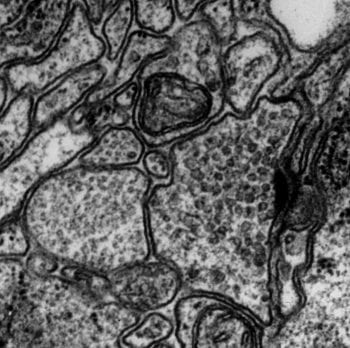My laboratory’s research is focused on understanding the molecular mechanisms that orchestrate the development, structural organization and secretory signaling functions of the presynaptic nerve terminal. I study the nematode C. elegans (Figure 1) because experimentally it can be manipulated with ease both molecularly and genetically, yet it still retains many features common to vertebrate systems. C. elegans uses all of the major transmitters, possesses a complex transmitter receptor and ion channel repertoire, and shares most molecular components with the vertebrate presynaptic apparatus.

I find synapses (Figure 2) fascinating because they are highly organized subcellular structures with an intricate architecture that is designed to facilitate rapid and reliable cell-cell signaling. In particular, my lab has concentrated on studying the presynaptic nerve terminal that secretes neurotransmitter via vesicular fusion of synaptic vesicles specifically at release sites called active zones. Synaptic vesicles are used repetitively via cycles of exocytosis and endocytosis. This process is often referred to as the synaptic vesicle cycle (Figure 3).
Currently, three major areas of research are under investigation in my lab. First, we are taking several approaches to identify signals that mediate the decision to assemble and maintain synaptic connections. Second, we are examing mechanisms that regulate the trafficking of synaptic component to the synapse. Third, we interested in dissecting the the pathways that underlie the formation of secretory vesicles in the soma. To address that we are examining glands which form large sized cargo vesicles. To address all these problems we use a combination of genetics, pharmacology, molecular biology, time-lapse microscopy, and cell biology.

